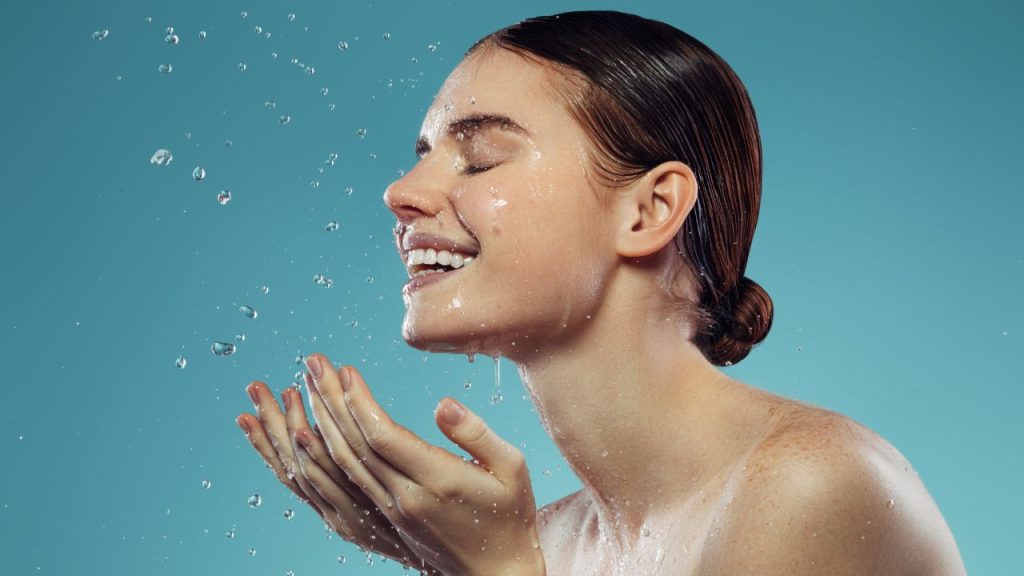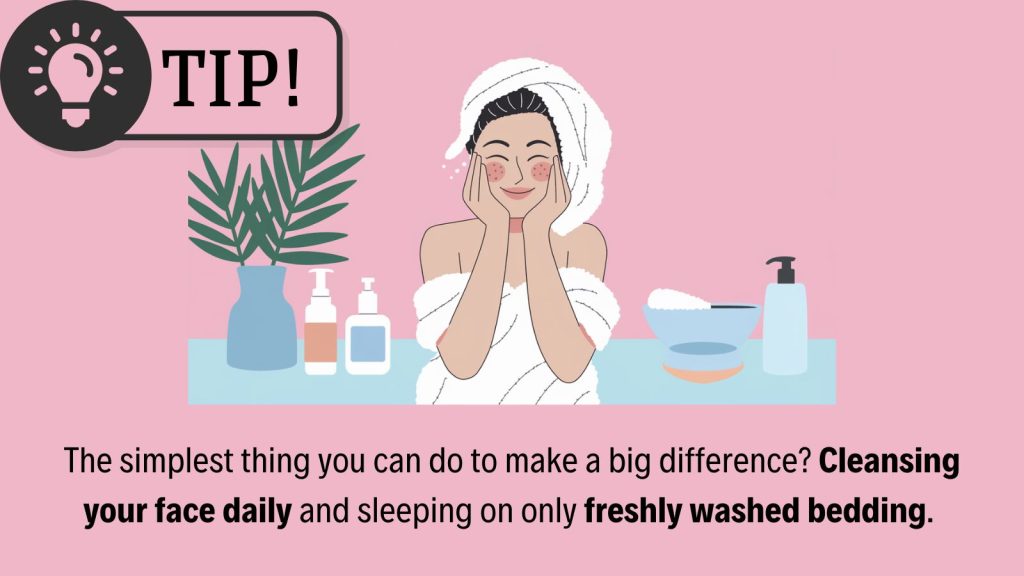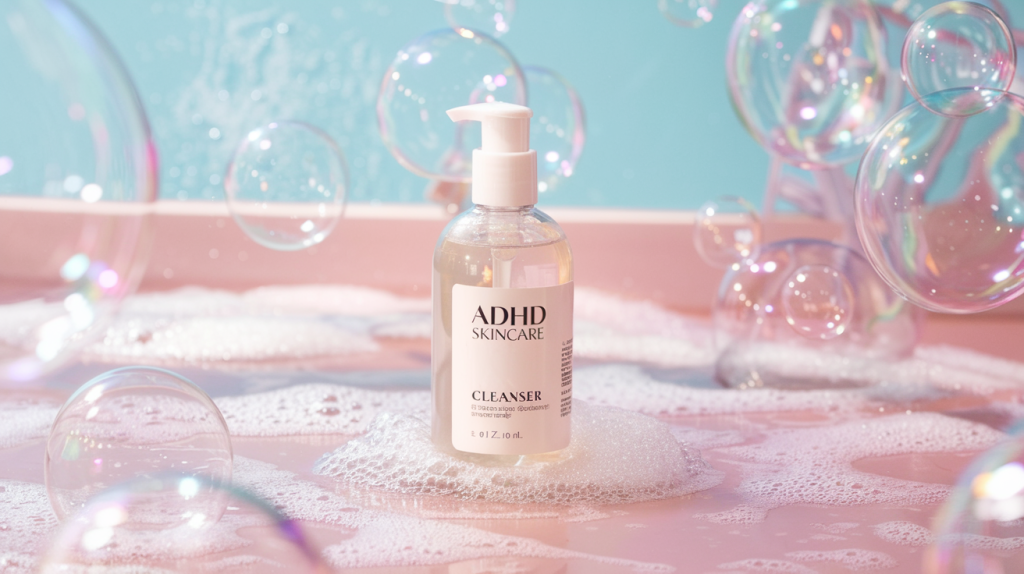
Note: This article is ADHD-friendly.
Face cleansing is so much more than just washing your face. Done right, it’s the foundation of glowing, healthy skin. Done wrong? It can lead to dryness, clogged pores, or irritation — and no amount of fancy serums will fix that.
But don’t worry! Understanding the science of cleansing can transform your skincare routine and make every step more effective.
Let’s start with the basics: What is a cleanser, and what does it do?
🧼 What Exactly Does a Cleanser Do?
Cleansers are like the janitors of your skincare routine. They contain surfactants (a fancy word for cleansing agents) that help water mix with oil, dirt, and gunk on your skin. This allows all the gross stuff to be broken down and washed away when you rinse.
If you don’t cleanse regularly, dirt and oil stick around, mix with dead skin cells, and clog your pores.
💀 The result? Acne, dull skin, and irritation.
🔹 Skin Therapist’s Tip:
Most of our clients see major improvement in their acne and skin texture just by:
✔️ Washing their face twice a day.
✔️ Sleeping on freshly washed bedding.

🧼 What Type of Facial Cleanser is Best for Your Skin?

Facial cleansers come in many textures:
🔹 Cleansing gels
🔹 Cleansing balms
🔹 Cleansing creams
🔹 Cleansing milks
🔹 Facial bars
🔹 Makeup removers
But the real game-changer? Focusing on ingredients, not texture.
🔍 Best Cleansers for Each Skin Type + Sensitive and Dehydrated Skin
Find your skin type below👇
😊 Normal Skin
✅ Choose balancing cleansers that maintain skin health.
Key actives and ingredients for normal skin:
- Hyaluronic Acid – Keeps skin hydrated.
- Aloe Vera – Soothes & prevents irritation.
- Vitamin E – Provides antioxidant protection.
❌ Avoid:
- Anything too stripping or too rich for your skin’s natural balance.
- Facial washes with harsh ingredients like alcohol, sulfates, parabens, artificial fragrances can strip and irritate your skin.
✅ Do:
- Stick to mild and gentle cleansers.
- Look for a pH between 4.5 and 5.5 (that’s skin-friendly and won’t wreck your moisture barrier)
- Wash gently with lukewarm water.
🌵 Dry Skin
✅ Choose hydrating, non-stripping cleansers (gel, cream, or oil-based are typically best).
Key actives and ingredients for dry skin:
- Glycerin – Attracts moisture to the skin.
- Hyaluronic Acid – Locks in hydration.
- Ceramides – Strengthens the skin barrier.
❌ Avoid:
- Anything too stripping or too rich for your skin’s natural balance.
- Facial washes with harsh ingredients like alcohol, sulfates, parabens, artificial fragrances can strip and irritate your skin.
✅ Do:
- Stick to mild and gentle cleansers.
- Look for a pH between 4.5 and 5.5 (that’s skin-friendly and won’t wreck your moisture barrier)
- Wash gently with lukewarm water.
💦 Oily Skin
✅ Clarifying but gentle cleansers (gel or foam-based).
Key actives and ingredients for oily skin:
- Salicylic Acid – Deep cleans pores & prevents breakouts.
- Niacinamide – Regulates oil production.
- Tea Tree Oil – Fights acne-causing bacteria.
❌Avoid:
- Harsh facial washes with ingredients like alcohol, sulfates, parabens, artificial fragrances can strip your skin and cause it to produce more oil.
✅ Do:
- Wash gently with lukewarm water.
- Use gentle products that won’t strip your skin and cause it to produce excessive oil to compensate.
- Look for a pH between 4.5 and 5.5 (that’s skin-friendly and won’t wreck your moisture barrier)
🤹 Combination Skin
✅ Balanced, gentle cleansers labeled “for all skin types“.
Key actives and ingredients for combination skin:
- Hyaluronic Acid – Hydrates without making skin greasy.
- Aloe Vera – Soothes & balances moisture levels.
- Chamomile – Reduces irritation.
❌Avoid:
- Facial washes with harsh ingredients like alcohol, sulfates, parabens, artificial fragrances can strip and irritate your skin.
- Over-drying cleansers that strip natural oils.
✅ Do:
- Stick to mild and gentle cleansers.
- Look for a pH between 4.5 and 5.5 (that’s skin-friendly and won’t wreck your moisture barrier)
- Always spend more time massaging the product into your oily zones and wash gently with lukewarm water.
😵💫 Sensitive Skin
✅ Mild, soothing, hypoallergenic cleansers.
Key actives and ingredients for sensitive skin:
- Aloe Vera – Calms redness & irritation.
- Colloidal Oatmeal – Strengthens skin barrier & reduces inflammation.
- Centella Asiatica – Repairs & soothes sensitive skin.
❌Avoid:
- Known allergens like essential oils, alcohol, sulfates, parabens, artificial fragrances, dye, can strip and irritate your skin.
- Harsh cleansers that strip natural oils.
✅ Do:
- Stick to mild and gentle cleansers.
- Look for a pH between 4.5 and 5.5 (that’s skin-friendly and won’t wreck your moisture barrier)
- Wash gently with lukewarm water
💧 Dehydrated Skin
✅ Hydrating, non-stripping, moisture-binding cleansers.
Key actives and ingredients for dehydrated skin:
- Hyaluronic Acid – Draws water into the skin for deep hydration.
- Glycerin – A humectant that prevents water loss.
- Panthenol (Vitamin B5) – Soothes, hydrates, and strengthens the skin barrier.
- Ceramides – Repair and reinforce the moisture barrier.
❌ Avoid:
- Harsh surfactants (SLS, SLES) that can strip moisture and worsen dehydration.
- High-alcohol formulas like denatured alcohol and isopropyl alcohol dehydrate the skin.
- Facial washes with harsh ingredients like alcohol, sulfates, parabens, artificial fragrances can strip and irritate your skin.
✅ Do:
- Use a hydrating, low-pH (4.5–5.5) cleanser to maintain balance.
- Apply humectants (hyaluronic acid, glycerin) to damp skin to maximize hydration.
- Wash with lukewarm water (hot water worsens dehydration).
🔖 TL;DR: Choosing the Right Cleanser
✔️ Hydrating ingredients → Dry skin.
✔️ Clarifying ingredients → Oily skin.
✔️ pH-balanced, mild cleansers → Sensitive & all skin types.
✔️ Twice-a-day cleansing + clean bedding = better skin.
✔️ Always wash gently with warm water.
Armed with the right products, you’re off to a good start. Next, you need to beware of the 4 biggest face washing mistakes.





